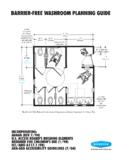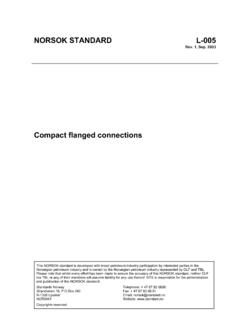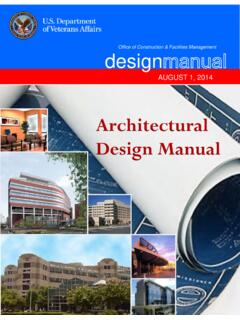Transcription of BARRIER-FREE WASHROOM PLANNING GUIDE - McClain …
1 36 "(927mm)61 "(1562mm)enlarged standardcompartment7'- 0"(2134mm)alternatecompartment 36" (914mm)wide not required,provided to create more universallyusable washrooma15'- 6" (472cm)66"(1676mm)C: (1753mm)69"18" (457mm) 24" (610mm) min.,preferred5' (1575mm)2"- countertoplavatories withknee space and aprotective panelbelowconventionalcompartment15'(462 cm)C: 15(470cm)2" - 5" - ' BARRIER-FREE WASHROOM PLANNING GUIDEINCORPORATING:ADAAG (REV 7/94) ACCESS BOARD'S BUILDING ELEMENTS DESIGNED FOR CHILDREN'S USE (1/98)ICC/ANSI (98)ADA-ABA ACCESSIBILITY GUIDELINES (7/04)Fig. 18 Small Public WASHROOM Provides Standard Compartment and Alternate Compartment 36" (914mm) ELEMENTS DESIGNEDFOR CHILDREN S USEF inal guidelines for making facilities accessible to children have been publishedby the Access Board ( Architectural and Transportation barriers ComplianceBoard), but not yet adopted by the Department of Justice.
2 While they are notyet enforceable, they offer guidance. Please refer to blue notations beginningwith C: in several of the GUIDE INCLUDES STANDARDST hese standards replace CABO/ANSI which have been adopted bymany states. A transition to the new standards is expected; please check with theappropriate agency in your ADA HAS OPENED THE DOORSOF ALL FACILITIESThe Americans with Disabilities Act(ADA) is a federal civil rights law thatprohibits discrimination against people with disabilities by ensuring them equalaccess to goods and services. It recognizes inaccessible facilities as one form ofdiscrimination, since these facilities can prohibit participation by people withdisabilities. The regulations for implementing the ADA include detailed designspecifications, originally known as ADA Accessibility Guidelines for Buildings andFacilities (ADAAG).
3 The Guidelines were developed by the US Architectural andTransportation barriers Compliance Board (the Access Board) using sections ofthe American National Standard for Buildings and Facilities ProvidingAccessibility and Usability for Physically Handicapped People (ANSI )and the Uniform Federal Accessibility standards (UFAS),with additional text foramplification and some new guidelines. In order to make the ADAAG enforceable,the Guidelines were subsequently amended and adopted by the US Departmentof Justice as the ADA standards for Accessible design (the standards ). The lawapplies to most buildings and facility types nationwide regardless of state or localcode requirements, but it is not a building code in and of itself. While Canada has a single nationwide building code, the United States untilnow has had a federal standard for federal buildings and programs only, and eachstate and local government has established its own building codes.
4 The ADA haschanged that by setting federal standards for all public accommodations, includingtransportation systems, and portions of commercialfacilities. Authority has beenleft with each state and local government to adopt and enforce its own buildingcodes, but the office of the Assistant Attorney General for Civil Rightshas theauthority under the ADA to certify that a state or local building code meets orexceeds the minimum requirements of ADA, and suchcertification of equivalencycan be used as rebuttable evidence in any subsequent litigation. To help everyonewith legal compliance, the federal government has established Disability andBusiness Technical Assistance Centers(DBTAC) in each region of the country. Public washrooms are one of the most critical building amenities with regardto accessibility and function for people with disabilities.
5 With one in four personsbecoming disabled sometime during their life, washrooms need to be responsiveto a wide range of human needs and abilities: including people without disabilitiesas well as those using wheelchairs and walking aids, people with sight or hearingdisabilities, impaired coordination, cardiac or pulmonary disorders,and even peopleaffected by temporary illness, pregnancy, or advancedage. The ADA requires that all washrooms, whether newly constructed or re-modeled, be usable by people with disabilities. This means that some of each typeof fixture or feature must meet BARRIER-FREE requirements. Therefore, BobrickWashroom Equipment, Inc. has prepared this GUIDE for use by planners, archi-tects, designers, specifiers, and building owners. In addition, Bobrick sArchitectural Representatives are available to assist with code interpretation andapplication of appropriate product specifications and installation criteria.
6 All build-ing plans, however, should be confirmed with local jurisdictions to ensurejob public accommodations and commercial facilities, theADAAG, or a state or local building code that has been certified as equivalent toADAAG by the Assistant Attorney General must be used. For state or local gov-ernment buildings, either ADAAG or UFAS standards must be used. Since manystates have adopted all or parts of UFAS, ANSI , or into their building codes there will be significant overlap on someprojects. The ADAAG, UFAS, and ANSI standards are similar; however, there aresignificant differences in the scope of their requirements and some differences intechnical specifications. Therefore, unless working from a certified local code, itis imperative that all relevant standards be used in conjunction with this advisoryplanning GUIDE to ensure legal compliance.
7 The dimensions in this PlanningGuide are taken from the ADAAG. However, because the ICC/ANSI the least similar in technical specifications to the other standards , ICC/ANSI dimensions are also shown where they deviate significantly or where complyingwith the ADAAG would not accomplish the same result. Of interest, WASHROOM requirements tend to be in between ADAAG andCABO/ANSI ADA ANDUNIVERSAL DESIGNThe ADA Title III requires all new construction of public accommodationsand commercial facilities meet or exceed ADAAG specifications. All additions andsubstantial alterations to functional spaces in existing public accommodations areconsidered new construction and subject to the same ADAAG requirements; andthe entrances, toilet facilities, and accessible routes that service the additions oraltered spaces may also have to be brought up to ADAAG public accommodations are required by the ADA Title III to removebarriers that are readily achievable based on an organization s size, resources,and the type and complexity of the barriers in question.
8 The regulations for thelaw do not precisely define the term readily achievable; however, they do providedetails on how to modify existing buildings and they give building owners logicalflexibility in coming up with alternative solutions to providing equal services forpeople with disabilities if it is deemed that removal of existing barriers is notreadily the ADA mandates widespread accessibility nationwide, it supports theconcept of universal designthat suggests designers and manufacturers include thenecessary characteristics and/or options in all products, building elements, andspaces to ensure that they are usable to the greatest extent possible by people withall types and levels of ability. This more universally usabledesign approach wouldinclude and surpass the minimum requirements of current standards and DESIGNcan be accomplished in some instances by simply usingthe same item for everyone; sometimes by positioning an item differently; at othertimes by modifying or replacing a single manufactured feature of an item; and insome circumstances by replacing an item with one that is more adjustable oradaptable.
9 Universal design eliminates radically different looking items and special labels ( , handicapped), and the stigma associated with them, whileproviding choices for all users. SPECIAL ISSUE OF LEFT- AND RIGHT-HAND ACCESSIBILITYS omepeople with disabilities can only use certain features if they can approach themfrom the left or right side. This limitation affects the usability of toilet and showercompartments and WASHROOM accessories that are not symmetrical. The ADAAG standards do not require that both left- and right-handed facilities be available inall washrooms; however, the concept of universal design suggests that whenwashrooms are planned, both left- and right-handed versions should be providedto the greatest extent possible (see Clear Floor Spaceon following page).33(Fig. 2b) is also acceptable and may be used to conserve space in some installa-tions.
10 A portion of the 60"(1524mm) diameter or T-shaped turning spaces may belocated under fixtures, lavatories, or accessories as long as the required knee andtoe clearance is provided (Fig. 4a).SPACE FOR PEOPLE IN WHEELCHAIRS IS A FUNDAMENTAL design CONSIDERATIONThe needs of a person seated in a wheelchair are commonly used as thestandard of accessibility for BARRIER-FREE washrooms in terms of entrance, exit,and the proximity of equipment. By using the wheelchair perspective you can alsoaccommodate a person using a walker, cane, or crutches. Consideration must alsobe given to the mounting heights of common accessories, such as mirrors, papertowel dispensers, waste receptacles, soap dispensers, napkin/tampon vendors,and toilet partition-mounted equipment, including grab bars, toilet tissue, and seat-cover dispensers, and sanitary napkin FLOOR SPACEto accommodate a single wheelchair must be at least30"x 48"(760 x 1219mm).






